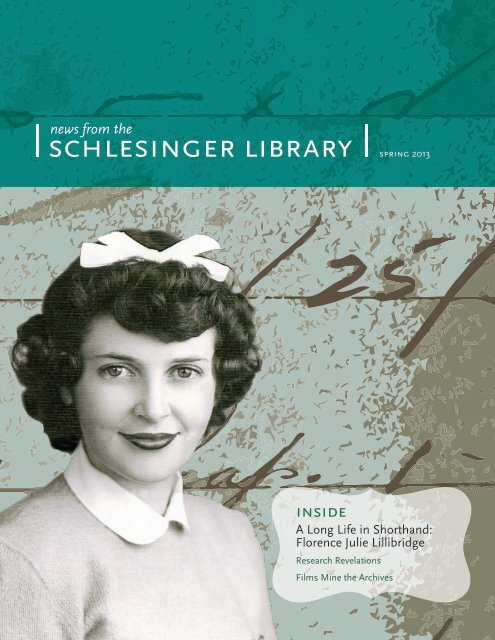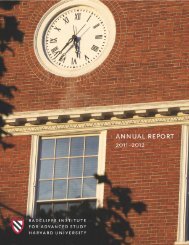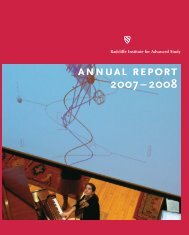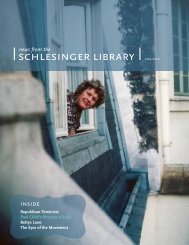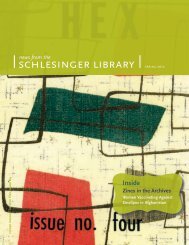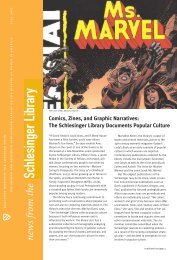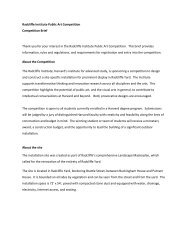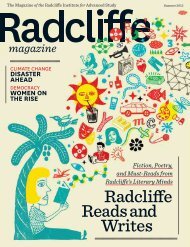Download - Radcliffe Institute for Advanced Study - Harvard University
Download - Radcliffe Institute for Advanced Study - Harvard University
Download - Radcliffe Institute for Advanced Study - Harvard University
You also want an ePaper? Increase the reach of your titles
YUMPU automatically turns print PDFs into web optimized ePapers that Google loves.
news from the<br />
schlesinger library<br />
spring 2013<br />
inside<br />
A Long Life in Shorthand:<br />
Florence Julie Lillibridge<br />
Research Revelations<br />
Films Mine the Archives
1<br />
Letter from the Director<br />
This is a year of important anniversaries. A half-century has<br />
passed since 1963, a signal year <strong>for</strong> the modern women’s<br />
movement. President Kennedy’s Commission on the Status<br />
of Women delivered its historic report in 1963, and Betty<br />
Friedan published The Feminine Mystique, a manifesto<br />
with consequences <strong>for</strong> hundreds of thousands of women.<br />
Proud to be the repository of Betty Friedan’s papers—and<br />
also those of many prime movers on the president’s commission,<br />
including its effective head, Esther Peterson—the<br />
Schlesinger Library will celebrate both anniversaries.<br />
We are planning a high-profile event in collaboration<br />
with the John F. Kennedy Library in Boston, highlighting the<br />
president’s commission and assessing where women have<br />
come in public and private life since its report. Then we will<br />
mark the anniversary of The Feminine Mystique in two ways:<br />
Our exhibit cases will hold selections from Friedan’s papers.<br />
(A <strong>for</strong>etaste—Alice Paul’s copy of The Feminine Mystique—<br />
can be viewed now under the Schlesinger Library’s “Picks<br />
and Finds” on the <strong>Radcliffe</strong> website. Paul, the militant<br />
suffragist leader and originator of the Equal Rights Amendment,<br />
bought Friedan’s book in 1963—when she herself was<br />
78—and marked up its pages with intensive comments.) We<br />
will also host a special event on November 19, celebrating<br />
Friedan’s book by reconsidering the questions of home and<br />
work in women’s lives.<br />
The library too, has an anniversary in 2013—its 70th! We<br />
are dedicating it to Gerda Lerner, the irreplaceable, irrepressible<br />
progenitor of the current field of women’s history, who<br />
passed away in January and whose papers are here at the<br />
Schlesinger. Five eminent historians—each of whom knew<br />
Lerner well—will assess the history of the field. Save the date<br />
of December 5.<br />
Gerda Lerner and Betty Friedan, different as they were,<br />
share some striking parallels. They were age-mates, born in<br />
1920 and 1921 respectively. Both were Jewish, though secular<br />
in practice. Both were known to be brusque, willful, and<br />
direct. Both married and had children and were politically on<br />
the left in the 1930s and 1940s. Each came into her own and<br />
began to make her mark as a leader of 20th-century feminism<br />
in her 40s, during the mid-1960s. Lerner earned her<br />
BA the year Friedan published The Feminine Mystique and<br />
her PhD the year Friedan and others founded the National<br />
Organization <strong>for</strong> Women. Much more might be said about<br />
these parallels—and others—and about the sharp differences<br />
between the lives of these two remarkable women, both<br />
of whom we specially honor this year.<br />
—Nancy F. Cott<br />
Carl and Lily P<strong>for</strong>zheimer Foundation Director<br />
Jonathan Trumbull Professor of American History<br />
Updates on the Maximum Access<br />
Project and Digitizing Collections<br />
Most special collections libraries accumulate large backlogs<br />
of unprocessed materials, and in 2008, the Schlesinger<br />
was no exception. Today, however, it most definitely is one.<br />
The backlog of published materials, determined in 2007 to<br />
be 11,000-plus volumes, has been completely eliminated.<br />
The manuscripts backlog, amounting to about 5,600 linear<br />
feet, has been reduced by 88 percent, leaving less than 900<br />
linear feet, in need of extensive arrangement and description.<br />
For audio and audiovisual materials, the percentages<br />
are similar. That backlog numbered about 16,000 items at<br />
the beginning of the project; by the end of FY 2013, 83 percent<br />
of the audio items and 80 percent of the video material<br />
will have been described.<br />
Un<strong>for</strong>tunately, we still have a significant backlog of photographs,<br />
with 92,740 items uncataloged, and an unknown<br />
amount of unprocessed collections. Equally challenging is<br />
a newly created category: approximately 225 gigabytes of<br />
digital files. These categories will continue to grow and will<br />
be our focus over the next several years. Yet our success in<br />
backlogs gives us great confidence as we move <strong>for</strong>ward in<br />
these new areas.<br />
Since 2008, the library has re<strong>for</strong>matted several large and<br />
significant 19th-century collections and a few heavily used<br />
collections documenting the lives of African American<br />
women, digitizing and making them available online. With<br />
help from generous donors, several large and complex<br />
in-house projects have made some of our most notable<br />
collections available to researchers throughout the world.<br />
Although we currently struggle with finding a fully efficient<br />
page-delivery method, all of these are accessible from links<br />
embedded in the finding aids:<br />
• Papers of Charlotte Perkins Gilman, 1846–1961<br />
• Beecher-Stowe Family Papers, 1798–1956<br />
• Susan B. Anthony Papers, 1815–1961<br />
• Civil War diaries from the Schlesinger Library<br />
• Papers of Dorothy West, ca. 1890–1998<br />
• Black Women Oral History Project interviews, 1976–1981<br />
• <strong>Radcliffe</strong> College publications<br />
The library has also signed an agreement with ProQuest<br />
to digitize the Schlesinger’s Women’s Rights Collection; that<br />
project will be completed in January 2014. Previously, the<br />
library contracted with the British publisher Adam Matthew<br />
Digital to digitize a large number of travel diaries and other<br />
travel writings in the Schlesinger’s holdings.<br />
—Marilyn Dunn<br />
Executive Director and <strong>Radcliffe</strong> <strong>Institute</strong> Librarian<br />
Citing Julia: In our last issue, we incorrectly stated that<br />
Reverend Peter Gomes wrote a song <strong>for</strong> Julia Child’s 80th<br />
birthday. Instead, he wrote the song <strong>for</strong> a going-away party<br />
hosted by Dorothy S. Zinberg in 2001, when Julia moved from<br />
Cambridge to Santa Barbara. The song and story were part of<br />
our “Siting Julia” conference in September 2013.
Patty Gelfman: Representing <strong>Radcliffe</strong> College Alumnae<br />
Several years ago, Patty Gelfman ’56 led her <strong>Radcliffe</strong> class<br />
to make a generous gift to the Schlesinger Library <strong>for</strong> its 50th<br />
reunion. That gift has funded the processing of some of the<br />
library’s most illustrious collections, including those of Betty<br />
Friedan, Charlotte Perkins Gilman, Elizabeth Holtzman, and<br />
Marge (the creator of Little Lulu cartoons).<br />
An interest in philanthropy comes naturally to Gelfman.<br />
Her father, Benjamin A. Trustman ’22, JD ’25, was a prominent<br />
Boston attorney whose gifts established the Trustman<br />
traveling fellowships <strong>for</strong> <strong>Harvard</strong> students and a scholarship<br />
fund at <strong>Harvard</strong> Law School.<br />
The Schlesinger was not a hard sell <strong>for</strong> <strong>Radcliffe</strong> alumnae,<br />
according to Gelfman. “The Schlesinger is a place that <strong>Radcliffe</strong><br />
women can relate to,” she says. “They understand that<br />
the library is about our history.”<br />
She has been involved with <strong>Radcliffe</strong> since she graduated<br />
cum laude with a degree in English. She served on the<br />
<strong>Radcliffe</strong> College Board of Trustees and the <strong>Radcliffe</strong> College<br />
Alumnae Association, participated in numerous reunion<br />
gift drives and campaign committees, and served on the<br />
library’s advisory committee.<br />
When the College evolved into the <strong>Institute</strong>, her work<br />
on behalf of <strong>Radcliffe</strong> continued. In 2003, she was asked to<br />
serve on the Schlesinger’s Library Council, where she repre-<br />
photo by stu rosner<br />
sents the concerns of <strong>Radcliffe</strong> College alumnae.<br />
<strong>Harvard</strong> <strong>University</strong> is important to many of Gelfman’s<br />
family members. Her husband, Robert W. Gelfman JD ’56,<br />
earned his law degree from <strong>Harvard</strong>, and her two children—<br />
Lisa Jane Gelfman Matthews ’82, MBA ’85 and Peter Trustman<br />
Gelfman ’86—also hold <strong>Harvard</strong> degrees, as does her<br />
son-in-law, Gary S. Matthews MBA ’86. Gelfman’s grandson<br />
James Matthews is currently a <strong>Harvard</strong> freshman.<br />
Be<strong>for</strong>e she had her children, Gelfman worked as a<br />
teacher in St. Paul, Minnesota, where she and her husband<br />
lived while he was a legal officer in the air <strong>for</strong>ce. After they<br />
moved to Scarsdale, New York, and began a family, she did<br />
substitute teaching and earned a master’s degree in early<br />
childhood education from the Bank Street College of Education<br />
while raising her two children. She also got involved<br />
with other <strong>Radcliffe</strong> alumnae in the area and became president<br />
of <strong>Radcliffe</strong>-in-Westchester, which led to her election to<br />
the College’s board of trustees.<br />
When she was ready to reenter the work<strong>for</strong>ce, Gelfman<br />
received assistance from the <strong>Radcliffe</strong> College development<br />
office, which she says helped her land a fundraising job at<br />
Barnard College. “For women my age, that was a big deal,<br />
to go from volunteer activity to getting paid <strong>for</strong> it,” she says.<br />
“The job could be the same, but that was a big step.”<br />
Gelfman never gave up her volunteer work. Be<strong>for</strong>e the<br />
job at Barnard, she had been education director of the White<br />
Plains Day Care Center, a Head Start program, and she later<br />
became development director of Planned Parenthood of<br />
Westchester County. Her interest in libraries led her to volunteer<br />
at the New York Public Library and at the library in the<br />
Cloisters, a branch of the Metropolitan Museum of Art. Along<br />
the way, she earned a certificate in managing archives.<br />
Spending time with her family—including five grandchildren—is<br />
one of Gelfman’s highest priorities. “We’re a<br />
very close family, and we’re very lucky that we live near one<br />
another,” she says. “As grandparents, we could participate<br />
in the kids’ lives as they were growing up. And we still do<br />
activities and take trips together. That has been a very big<br />
part of my life.” The family’s most recent trip was to London,<br />
to celebrate her husband’s 80th birthday.<br />
Gelfman says she has always enjoyed coming to Cambridge<br />
to participate in <strong>Radcliffe</strong> activities. She attends as<br />
many <strong>Institute</strong> events as she can, including the recent Julia<br />
Child symposium and the science and gender conferences.<br />
And of course she stays up-to-date on the Schlesinger’s<br />
activities. “They’re at the <strong>for</strong>efront of digitization, which fascinates<br />
me,” she says. “It’s so important <strong>for</strong> the future.”<br />
—Pat Harrison<br />
Publications Manager<br />
2
writing in code<br />
One Woman’s Diaries, Covering More than 30 Years, Offer an<br />
While colleagues will say that I’ve never met a diary that I<br />
didn’t want <strong>for</strong> the library, not every diary we encounter is<br />
truly right <strong>for</strong> us. Whether a diary is donated or we encounter<br />
it on eBay, I must ask several questions to determine if it is a<br />
good fit <strong>for</strong> our collection.<br />
One woman’s diary, the gift of her widower, arrived under<br />
particularly unusual circumstances.<br />
In early 2000, I got a call from Don Lillibridge, a professor<br />
emeritus of history at Chico State <strong>University</strong> in Cali<strong>for</strong>nia.<br />
He was then 82, and his wife of 56 years, Florence Julie<br />
Lillibridge, had recently died at age 80. Florence, who had<br />
been an English teacher and then the dean of girls at a high<br />
school, had kept a diary <strong>for</strong> more than 30 years—from 1967<br />
to 1998—writing entries in big red American Express daybooks.<br />
Would the Schlesinger Library like to have them<br />
I asked Don Lillibridge if he could tell me something about<br />
the entries. “Don’t have a clue,” he said. “Flo wrote them in<br />
Gregg shorthand, but I’m willing to pay <strong>for</strong> transcriptions if<br />
you can find someone to do it.”<br />
It is, we discovered, very difficult to find anyone who can<br />
read and transcribe Gregg shorthand. Staff members at<br />
several Katharine Gibbs schools just laughed at the inquiry.<br />
Finally an ad in the <strong>Harvard</strong> <strong>University</strong> Retirees Association<br />
newsletter drew encouraging responses from several retired<br />
department secretaries, and Don’s posting to a similar<br />
organization <strong>for</strong> <strong>University</strong> of Cali<strong>for</strong>nia retirees identified<br />
several others. As a first step, Don photocopied a few<br />
entries from each decade, and I sent them off to potential<br />
transcribers as a test—I was concerned that Flo’s shorthand<br />
might have become so idiosyncratic over time that no<br />
one else could read it.<br />
The women sent back the entries and reported that<br />
all were legible. In one entry from New Year’s Day in the<br />
early 1990s, Flo recounted having gone to a party the night<br />
be<strong>for</strong>e, drinking a few martinis, and coming home: “Went<br />
to bed. Made love <strong>for</strong> the first time in a long time. It was<br />
grand!!!!!” Don called as soon as he received these transcribed<br />
pages. “I hope this didn’t shock you,” he said. “Are<br />
you still interested” No—and yes. The entries were long,<br />
detailed, and introspective. Flo was an articulate chronicler<br />
and assessor of her own life, of her family and her marriage,<br />
and of the world around her: she wrote of diets, disappointments,<br />
joys, aging, and illness.<br />
Don took charge of farming out all 32 volumes to more<br />
than a dozen transcribers across the country—11 women<br />
and the members of the Oakland County Chapter of the<br />
International Association of Administrative Professionals in<br />
Royal Oak, Michigan —and the project began. One woman<br />
transcribed 12 volumes; another, 8. Don introduced them<br />
to one another via e-mail so that they could solve problems<br />
together, and in no time, these women began calling<br />
themselves the FOF (Friends of Flo). They read the books<br />
Flo read and cooked the recipes she jotted down. They sent<br />
Don birthday gifts and Christmas cards. They wrote to tell<br />
me how much being a part of this project, of helping Flo<br />
find her voice, meant to them.<br />
Don found much of this surprising, but most surprising to<br />
me was this: He had the FOF send their completed transcriptions<br />
and the original diaries directly to me. Although he<br />
spent nearly $10,000 to have them transcribed, he had no<br />
interest in reading them. He trusted that Flo loved him until<br />
the end (she did); he was happy to let her speak <strong>for</strong> herself;<br />
and he hoped he was doing the right thing by placing her<br />
diaries in an archive. He was delighted and relieved when<br />
we shared with him an entry from another New Year’s Day,<br />
in which Flo wrote: “Well, another year, another diary. I don’t<br />
know why I keep it up. But I hope someday someone will<br />
read them and have a sense of who I am and what I did.”<br />
After the last of the diaries and transcriptions arrived, our<br />
correspondence with Don gradually ended, but not be<strong>for</strong>e he<br />
wrote to tell us he was happily remarried. This January two<br />
cartons arrived out of the blue from Cali<strong>for</strong>nia. Inside were<br />
24 of Don’s diaries—written in legible English—covering<br />
1988 through May 2012. He had died in December, and his<br />
widow wrote that he’d hoped we might want to add his voice<br />
to Flo’s. Indeed we do—although their diaries are closed<br />
<strong>for</strong> several years, out of Don’s concern <strong>for</strong> the privacy of his<br />
children and grandchildren.<br />
There is a decade of overlap between Don’s and Flo’s<br />
diaries: 10 years during which they each reflected on current<br />
events, on their children, on each other, on their joint ef<strong>for</strong>ts<br />
to stop smoking; 10 years during which each offered her/his<br />
personal perspective on their long marriage and their shared<br />
lives. What a remarkable gift to future researchers.<br />
—Kathryn Allamong Jacob<br />
Johanna-Maria Fraenkel Curator of Manuscripts at the<br />
Schlesinger Library<br />
3
er an Unexpected Riddle<br />
Don and Florence Lillibridge, 1962<br />
Among the library’s 3,000-plus<br />
manuscript collections are the<br />
diaries of more than 350 women—<br />
Lowell mill girls, abolitionists,<br />
suffragists, housewives, political<br />
activists, college students, photographers,<br />
feminists, women who<br />
were dying, women who were<br />
mentally ill, young campers, and<br />
elderly widows. Sometimes we have<br />
only two or three years of a woman’s<br />
diary, a very brief glimpse into<br />
her life. For other women, we have<br />
dozens of volumes spanning<br />
several decades and revealing the<br />
arc of their lives.<br />
Florence Julie Lillibridge, ca. 1923, Omaha, Nebraska<br />
All images are from the Lillibridge collection at the Schlesinger Library.<br />
4
adcliffe fellows using the schlesinger library<br />
The Musical Life of Shirley Graham Du Bois<br />
One of the most valuable aspects of my time at <strong>Radcliffe</strong> has<br />
been having access to the Schlesinger Library’s collection of<br />
Shirley Graham Du Bois’s papers. Gerald Horne’s magnificent<br />
biography of this pioneering musician, writer, and political<br />
activist had raised my interest in her musical output, and I<br />
knew be<strong>for</strong>e arriving that I would revel in the opportunity to<br />
pore over the score of her opera Tom Tom, which premiered in<br />
Cleveland, Ohio, in 1931.<br />
What a wonderful surprise it was to discover some additional<br />
songs in manuscript <strong>for</strong>m, including a setting of<br />
(music composed specifically <strong>for</strong>) a poem by her brother<br />
Lorenz Graham and a setting of Paul Laurence Dunbar’s<br />
poem “Compensation.” I have been interested in Dunbar’s<br />
poetry, which draws on both vernacular dialect <strong>for</strong>ms and<br />
elevated, sometimes even archaic, diction to capture two<br />
poles of African American expressive culture at the turn of<br />
the 20th century. His poetry has fired the imagination of successive<br />
generations of black composers, including Samuel<br />
Coleridge-Taylor, Betty Jackson King, Adolphus Hailstork,<br />
and many others, so I was especially delighted to discover<br />
Du Bois’s song in the collection.<br />
Like many other art songs (solo vocal pieces with piano<br />
accompaniment) by black composers, “Compensation”<br />
has not been recorded. This spring my <strong>Radcliffe</strong> research<br />
partner, Cansu Colakoglu ’16, and I have been preparing to<br />
per<strong>for</strong>m the song as part of my fellow’s presentation in May.<br />
My research shows how composers like Du Bois enrich our<br />
understanding of poetry through the musical “illustration” of<br />
their settings. Du Bois’s use of melodies from spirituals such<br />
as “Nobody Knows the Trouble I’ve Seen” and “Swing Low,<br />
Sweet Chariot” offers a rich musical and poetic intertextual<br />
reading of Dunbar’s lament <strong>for</strong> unrequited love.<br />
Tsitsi Jaji<br />
photo by tony rinaldo<br />
— Tsitsi Jaji<br />
Jaji is the 2012–2013 Mary I. Bunting <strong>Institute</strong> Fellow at the<br />
<strong>Radcliffe</strong> <strong>Institute</strong> and an assistant professor of English at the<br />
<strong>University</strong> of Pennsylvania. A recording of her fellow’s<br />
presentation is available at www.radcliffe.harvard.edu.<br />
Above: A page from Shirley Graham Du Bois’s college<br />
scrapbook. She attended Oberlin from 1930 to 1934.<br />
Right: Portrait of Du Bois.<br />
Both images from the Papers of Shirley Graham Du Bois at the<br />
Schlesinger Library.<br />
5
photo by tony rinaldo<br />
Equal Access: From Railcars to Websites<br />
Jonathan Lazar<br />
photo by tony rinaldo<br />
When I first arrived at the <strong>Radcliffe</strong> <strong>Institute</strong>, I attended a<br />
luncheon where I sat with a few librarians from the Schlesinger<br />
Library. When they heard that I was a professor of computer<br />
and in<strong>for</strong>mation sciences, they said, “Sorry, we probably<br />
won’t be able to assist you much—you may have more<br />
luck finding technology-related books at the Cabot Science<br />
Library.” Then I told them more about my fellowship project,<br />
about the societal discrimination that occurs when people<br />
with disabilities don’t have equal access to websites, and the<br />
librarians perked up. When I said that I wanted help learning<br />
more about the history of civil rights movements and how<br />
separate accommodations were often unequal, the librarians<br />
said, “We can definitely help with that.”<br />
The librarians at the Schlesinger connected me with<br />
reference material and introduced me to a faculty member<br />
with expertise on the topic. For example, I learned that there<br />
were often separate railroad cars <strong>for</strong> women in the United<br />
States in the late 1800s. These cars were generally cleaner<br />
and were considered to be “safer” <strong>for</strong> women, although<br />
there was no legal or policy requirement <strong>for</strong> segregated railroad<br />
cars <strong>for</strong> them. Often, black women were excluded from<br />
the women’s railcar. And black women often legally challenged<br />
the fact that they were required to pay the same train<br />
fare as white women but received inferior accommodations.<br />
This historical fact directly connects with my work on how<br />
people with disabilities, when they cannot access websites,<br />
receive unequal treatment or pay higher prices.<br />
—Jonathan Lazar<br />
Lazar, the 2012–2013 Shutzer Fellow at the <strong>Radcliffe</strong> <strong>Institute</strong>, is<br />
a professor of computer and in<strong>for</strong>mation sciences and the<br />
founder and director of the Universal Usability Laboratory a<br />
Towson <strong>University</strong>.<br />
A Pullman car en route to Boston on the Burlington Route stopped at Main Street in Keene, New Hampshire,<br />
1883, by J.A. French, Keene NH<br />
6
new grant to digitize<br />
blackwell collections<br />
In late January 2013, the Schlesinger<br />
Library announced the launch of a new<br />
digitization project supported by a grant<br />
from the National Historical Publications<br />
and Records Commission. The $150,000<br />
grant funds a two-year project to digitize<br />
five Blackwell Family Collections, which<br />
span 1784 to 1981 and detail the activities<br />
of members of the Blackwell family<br />
who were leaders in abolition, prohibition,<br />
health care, women’s suffrage, and<br />
education.<br />
The Schlesinger Library will invest an<br />
additional $150,000 to meet the cost of<br />
the project, titled “Those Extraordinary<br />
Blackwells: Leaders of Social Re<strong>for</strong>m in<br />
19th- and 20th-Century America.”<br />
Blackwell family members include<br />
Elizabeth Blackwell, the first woman in<br />
America to receive a medical degree;<br />
her sister Emily, also a physician; their<br />
brother Henry, a noted abolitionist and<br />
women’s suffrage activist; his wife, Lucy<br />
Stone, the famous women’s suffrage<br />
leader; their daughter, Alice Stone Blackwell,<br />
active in both suffrage and temperance;<br />
and Antoinette Brown Blackwell<br />
(sister-in-law to Elizabeth, Emily, and<br />
Henry), a re<strong>for</strong>mer and the first woman<br />
in the United States to become an<br />
ordained minister.<br />
The collection includes materials that<br />
record travel, professional work, and civic<br />
and re<strong>for</strong>m activities of members of the<br />
close-knit family.<br />
The project is scheduled to be<br />
completed in June 2015.<br />
The stamp issued in 1974 by the United<br />
States Postal Service in honor of Elizabeth<br />
Blackwell<br />
7
elizabeth blackwell’s struggle<br />
to become a doctor<br />
“I hated everything connected with the body, and could<br />
not bear the sight of a medical book,” Elizabeth Blackwell<br />
(1821–1910) wrote in her book about the medical profession,<br />
published in 1895. It wasn’t an interest in science or anatomy<br />
that motivated her to become the first woman in America<br />
to earn a medical degree; it was a dying friend’s plaint that<br />
she would have fared better if she’d had a “lady doctor.”<br />
Another reason Blackwell sought an “absorbing occupation,”<br />
as she put it, was to avoid the pitfalls of love. Around<br />
the time of her friend’s death, Blackwell wrote in her diary<br />
after suffering in love, “I felt more determined than ever to<br />
become a physician, and thus place a strong barrier between<br />
me and all ordinary marriage. I must have something to<br />
engross my thoughts, some object in life which will fill this<br />
vacuum and prevent this sad wearing away of the heart.”<br />
Blackwell’s family encouraged her plan, and two of her<br />
brothers drove her to North Carolina from her home in Cincinnati<br />
so that she could teach school and begin preparing<br />
<strong>for</strong> medical education.<br />
The third daughter in a family of five girls and four boys,<br />
Elizabeth was born in England and moved to America with<br />
her family at age 11. Her father, Samuel Blackwell, initially<br />
owned a sugar refinery in New York City, but moved the family<br />
to Cincinnati after it burned down and the rebuilt business<br />
failed.<br />
Samuel Blackwell was a social re<strong>for</strong>mer who saw to it<br />
that his daughters as well as his sons were well educated<br />
and developed their talents. Several of the Blackwell children<br />
would go on to great achievements. Elizabeth’s older sister<br />
Anna was a poet, translator, and journalist who wrote <strong>for</strong><br />
many newspapers in the United States and other countries,<br />
and her younger sister Emily also studied medicine, earning<br />
her degree a few years after Elizabeth. Henry Blackwell, one<br />
of Elizabeth’s younger brothers, became an editor, journalist,<br />
and businessman and the husband of Lucy Stone, a prominent<br />
abolitionist and suffragist.<br />
After a year teaching and studying in North Carolina,<br />
Elizabeth Blackwell moved to Philadelphia, then considered<br />
the seat of medical learning in America, and applied <strong>for</strong> admission<br />
to the four medical colleges there. She was turned<br />
down by all, although a professor at the largest school<br />
told her she could enter if she disguised herself as a man.<br />
Another professor advised her to go to Paris <strong>for</strong> medical<br />
training. “But neither the advice to go to Paris nor the suggestion<br />
of disguise tempted me <strong>for</strong> a moment,” Elizabeth<br />
wrote. “It was to my mind a moral crusade on which I had<br />
entered, a course of justice and common sense, and it must<br />
be pursued in the light of day, and with public sanction, in<br />
order to accomplish its end.”<br />
Blackwell broadened her search to include the smaller<br />
schools of the northern states—“country schools,” as they<br />
were called. Among them was Geneva Medical College, in<br />
upstate New York, which accepted her, by vote not of the faculty<br />
but of the students. In October 1847, the entire medical<br />
class at Geneva adopted a resolution stating in part that “to<br />
every branch of scientific education the door should be open<br />
equally to all; that the application of Elizabeth Blackwell to<br />
become a member of our class meets our entire approbation;<br />
and in extending our unanimous invitation we pledge<br />
ourselves that no conduct of ours shall cause her to regret<br />
her attendance at this institution.”<br />
At last she was in. Blackwell accepted Geneva’s invitation<br />
immediately and left Philadelphia on a train in early November,<br />
headed <strong>for</strong> upstate New York.<br />
During her two years at Geneva, the male students accepted<br />
her and treated her well. But Blackwell slowly realized<br />
that many women in the small town considered her odd,<br />
so she kept to herself. “I never walked abroad,” she wrote,<br />
“but hastening daily to my college as to a sure refuge, I knew<br />
when I shut the great doors behind me that I shut out all<br />
unkindly criticism, and I soon felt perfectly at home amongst<br />
my fellow-students.”<br />
When she received her medical degree, in 1849, the news<br />
traveled far. The editor of The National Era, a weekly newspaper<br />
in Washington, DC, wrote a long article about her. “She<br />
is one of those who cannot be hedged up, or turned aside,<br />
or defeated,” he concluded. “She is a woman, not of words,<br />
but of deeds; and all those who only want to talk about it,<br />
may as well give up.”<br />
In the years that followed, Blackwell founded a hospital<br />
<strong>for</strong> indigent women and children and a medical college <strong>for</strong><br />
women. She returned to England, where she died in 1910. In<br />
1974, the US Postal Service issued a stamp honoring her as<br />
the first woman physician.<br />
—Pat Harrison<br />
Publications Manager<br />
8
joanna behrman ’13<br />
Physics Education at<br />
<strong>Radcliffe</strong> and <strong>Harvard</strong><br />
photo by tony rinaldo<br />
Joanna Behrman considered Bryn Mawr when she was<br />
looking at colleges. “I immediately felt a strong sense of<br />
community there, but <strong>Harvard</strong> could offer so many more resources,”<br />
she says. “And <strong>Harvard</strong> does have the best physics<br />
department in the world.”<br />
Now in her senior year, Behrman is obviously proud of<br />
her soon-to-be alma mater. She plans to become a physics<br />
professor and is considering graduate programs. An ardent<br />
student, she’s writing a thesis, even though the <strong>Harvard</strong><br />
physics department doesn’t require one. Her topic—a comparison<br />
of undergraduate physics teaching at <strong>Harvard</strong> and<br />
<strong>Radcliffe</strong> from 1895 to 1953—led her to the Schlesinger Library,<br />
where she applied <strong>for</strong> and won a Carol K. P<strong>for</strong>zheimer<br />
Student Fellowship to begin her research during the summer<br />
of 2012.<br />
Behrman is concerned about the lack of gender diversity<br />
in her field. “Physics has a problem with cultural diversity,<br />
and it lags behind all the other sciences in terms of gender<br />
parity,” she says. “Only mechanical engineering is worse.”<br />
She’s aware of existing research that finds undergraduate<br />
education to be the leakiest part of the pipeline to careers<br />
in physics. It’s also known that women’s colleges tend to<br />
produce proportionally more physicists than coed colleges.<br />
So Behrman decided to conduct a scientific experiment with<br />
<strong>Radcliffe</strong> and <strong>Harvard</strong>. “Here we have a women’s college and<br />
a men’s college with the same faculty and at least nominally<br />
the same education,” she says. “I wanted to see what the<br />
undergraduate physics experience was like at both colleges.”<br />
Behrman spent months going through archival material<br />
stored at the Schlesinger Library. “They have amazing<br />
digital collections,” she says. “I looked at everything they<br />
have online: yearbooks, enrollment records, annual reports.<br />
I was able to do very nitty-gritty data collection that feels very<br />
solid, that I can track very easily.”<br />
She also looked at manuscript records that gave her a feel<br />
<strong>for</strong> the time period. For those, she went online in the catalog<br />
and searched “women, physics.” Or “Schlesinger Library,<br />
physics.” “I literally went through every single entry trying<br />
to determine if there was anything that could possibly be of<br />
use,” she says.<br />
Although <strong>Radcliffe</strong> told prospective students that they<br />
would get the same education as <strong>Harvard</strong> students because<br />
the faculty and resources were the same, Behrman says she<br />
found that the education was not equal at all. “It tended to<br />
be doctoral students and junior faculty who taught at <strong>Radcliffe</strong>,”<br />
she says. “Sometimes the teachers didn’t even have<br />
their PhDs and might be only two or three years older than<br />
the <strong>Radcliffe</strong> women.”<br />
In 1943, because of World War II, there weren’t enough<br />
men at <strong>Harvard</strong> to justify teaching the classes separately, so<br />
9<br />
photo by Tony Rinaldo
some classes became coed. Behrman discovered that there<br />
was even a woman teaching physics that year. But she can<br />
find nothing about her in the physics archive. “There’s just a<br />
blank,” she says. She found the woman’s name in the <strong>Radcliffe</strong><br />
course catalog, but nowhere else. “I suspect she was<br />
someone’s wife who had maybe taken a degree in physics,”<br />
Behrman says. “I know by her name that she was married,<br />
but I’m still trying to track her down.”<br />
She found only two women who went on from <strong>Radcliffe</strong><br />
to pursue careers in physics. Marian Butler ’50 earned a<br />
master’s and went into industry, where she conducted<br />
research, and Margaret Kivelson, also Class of 1950, earned<br />
her PhD at <strong>Harvard</strong> in 1957 and went into academia, where<br />
she conducted research in plasma and space physics.<br />
Kivelson is now a professor emerita of space physics at the<br />
<strong>University</strong> of Cali<strong>for</strong>nia at Los Angeles.<br />
“<strong>Radcliffe</strong> was very good at producing astronomers,<br />
because the <strong>Harvard</strong> College Observatory and its director,<br />
Harlow Shapley, provided employment,” Behrman says. “It<br />
became very normal to have female astronomers, but it was<br />
still abnormal to have a female physicist.”<br />
Behrman is heartened by how far women have come<br />
since the time she’s researching and writing about. She says<br />
her thesis advisor, Howard Georgi, a <strong>Harvard</strong> College Professor<br />
and a Mallinckrodt Professor of Physics, is very supportive<br />
of women in physics and has actively recruited them into<br />
the field. Although she hasn’t taken any classes with Melissa<br />
Franklin, also a Mallinckrodt Professor of Physics—who held<br />
a <strong>Radcliffe</strong> <strong>Institute</strong> fellowship in 2004–2005 and subsequently<br />
became chair of the department—Behrman is well<br />
aware that Franklin was the first woman to receive tenure<br />
in physics at <strong>Harvard</strong>, in 1992. Franklin gave her access to<br />
<strong>Harvard</strong>’s physics archives <strong>for</strong> her thesis research.<br />
Behrman’s own story at <strong>Harvard</strong> is cautionary. “It turns<br />
out that the best high school in math and science in Wichita,<br />
Kansas, is nowhere near as good as some of the high<br />
schools other <strong>Harvard</strong> students attended,” she says. “I came<br />
here very bright-eyed and happy, saying ‘I can do this, I love<br />
math and science.’ Then my first couple of semesters were<br />
very difficult.”<br />
Behrman’s mother, a professor of physics and math<br />
at Wichita State <strong>University</strong>, gave her a lot of support, and<br />
Behrman joined study groups, which she says tend to <strong>for</strong>m<br />
along gender lines. Plus, no surprise, she worked hard.<br />
Later, as copresident of the Society of Physics Students, she<br />
helped other students understand that after about two years,<br />
everyone’s preparation evens out.<br />
—Pat Harrison<br />
Publications Manager<br />
A physics class at <strong>Radcliffe</strong>, 1912, from the <strong>Radcliffe</strong> College Archives, Schlesinger Library
11<br />
william William Simmons simmons ’14: From ’14<br />
From<br />
4-H to Judy<br />
4-H<br />
Chicago<br />
to Judy Chicago<br />
When he was growing up in Dixon, Cali<strong>for</strong>nia—a small town<br />
in the northern part of the state—William Simmons was<br />
active in the 4-H program, raising sheep, dairy goats, and<br />
poultry. In high school, he became a leader in 4-H—the<br />
state ambassador—and dreamed of having his own dairygoat<br />
farm.<br />
Flash <strong>for</strong>ward to <strong>Harvard</strong>, where Simmons is now a junior<br />
living in P<strong>for</strong>zheimer House, concentrating in the history of<br />
art and architecture and in lesbian, gay, bisexual, and transgender<br />
studies. One day he looked up the subject of 4-H on<br />
HOLLIS, the online catalog <strong>for</strong> the <strong>Harvard</strong> libraries, and<br />
discovered the Eloise Saunders Papers at the Schlesinger<br />
Library. Saunders participated in 4-H <strong>for</strong> most of her life, as<br />
a member and a leader.<br />
Simmons pored over Saunders’s papers, becoming fascinated<br />
with the young Eloise, who grew up in Westerly, Rhode<br />
Island, longing to have a pullet farm. He describes the diaries<br />
she kept from her 20s till her death: “She has all these<br />
loving descriptions of her chickens, and she combines this<br />
with deep knowledge of farm operations. She keeps records<br />
of laying, production, vaccination, feed, and expenses.”<br />
Wanting to delve more deeply into Saunders’s papers,<br />
Simmons applied <strong>for</strong> and won a Carol K. P<strong>for</strong>zheimer Student<br />
Fellowship from the library. Now he’s writing an article<br />
about her passion <strong>for</strong> agriculture and community that he<br />
hopes to get published. He’s getting help with his project<br />
from Jill Lepore, the David Woods Kemper ’41 Professor of<br />
American History and a <strong>Harvard</strong> College Professor. “My first<br />
hope,” he says, “is that this project will be useful <strong>for</strong> the 4-H<br />
program. I’d like to see local 4-H communities do their own<br />
research about their <strong>for</strong>efathers and <strong>for</strong>emothers.”<br />
Simmons’s work has already appeared in more than one<br />
publication. After he discovered that the Schlesinger has<br />
a portion of Judy Chicago’s papers, he dug into them and<br />
decided he wanted to interview Chicago about her work. He<br />
sent her an e-mail, to which she responded, and the resulting<br />
interview was published in the <strong>Harvard</strong> Independent. A<br />
longer version, which includes a personal narrative about his<br />
going to see The Dinner Party, Chicago’s signature work, at<br />
the Brooklyn Museum, was published in Notes, a magazine<br />
of the universities of Ox<strong>for</strong>d and Cambridge.<br />
“When I entered the large room that housed the famed<br />
piece,” he writes, “I understood the incredible potency of experiencing<br />
art firsthand. It is in this moment of discovery, of<br />
intimacy, that one can become a part of a grander narrative,<br />
specifically, the historically mediated connection between the<br />
artist and the audience.”
the late 1990s, the prints, he says, “show a lot of uncertainty<br />
about the labels we assign, like woman, man, gay,<br />
and straight.”<br />
Planning beyond the spring of 2014, he hopes to finish<br />
his thesis on the photographer Jimmy De Sana (1949–<br />
1990)—a member of New York’s punk scene during the<br />
1970s and 1980s—and curate a show of his work. This<br />
project has Simmons working with De Sana’s friend Laurie<br />
Simmons (no relation), a New York photographer and<br />
director who is the executor of De Sana’s estate and the<br />
mother of Lena Dunham, producer of and actor in the<br />
HBO television series Girls.<br />
How do Eloise Saunders, Judy Chicago, and Jimmy De<br />
Sana relate to one another “They all have potential to trans<strong>for</strong>m<br />
the way people think about history,” Simmons says.<br />
—Pat Harrison<br />
Publications Manager<br />
photo by tony rinaldo<br />
Simmons was so moved by The Dinner Party that he<br />
looked <strong>for</strong> more of Chicago’s work while he was doing<br />
research in the summer of 2012 at the <strong>University</strong> of Cambridge.<br />
At the university’s New Hall/Murray Edwards College,<br />
Simmons visited the New Hall Art Collection, which<br />
consists solely of work by women artists and is the most<br />
significant collection of its kind in Europe. When he asked to<br />
see their work by Judy Chicago, he was shown a set of prints<br />
called Song of Songs.<br />
“Judy juxtaposed a print with text from a new translation<br />
of Song of Songs, in which the speakers are given gendered<br />
pronouns,” Simmons says. “So one is he talking and one<br />
is she talking.” He decided that these prints would provide<br />
a good way to discuss how Chicago’s art and the art of her<br />
generation have evolved and remain important.<br />
In the fall of 2014, Simmons will curate a show of<br />
these prints at the <strong>University</strong> of Cambridge. Created in<br />
Judy Chicago with The Dinner Party at the San Francisco Museum<br />
of Modern Art in 1979, from the Judy Chicago Papers at the<br />
Schlesinger Library<br />
12
films mine the archives<br />
Movie Producers Head to the Schlesinger<br />
Library to In<strong>for</strong>m Their Works<br />
Taking a film from paper to screen has many hidden processes.<br />
And we don’t just mean craft services. Consider<br />
documentaries, <strong>for</strong> example: Each one—whether airing on<br />
your local public television station or playing film festivals<br />
around the world—relies on hours of research and stacks<br />
of supporting materials. Where is that research done Who<br />
supplies the supporting photographs or film clips Increasingly,<br />
thanks to its treasure trove of materials about women’s<br />
lives in America, the answer is the Schlesinger Library.<br />
Diana Carey, a reference librarian in charge of visual resources<br />
at the library, handles research requests from movie<br />
producers—usually one every couple of months, although<br />
she’s noticed a slight uptick in inquiries recently. The pace<br />
can be demanding at times. “It’s not that I get a lot of<br />
requests,” she says. “But often they need so many different<br />
things—and they need them really fast.” Compounding the<br />
problem is the fact that most of the filmmakers are outside<br />
the Boston area and can’t do the research themselves.<br />
Most of the requests are <strong>for</strong> photos, but some are <strong>for</strong><br />
audiovisual materials. “We have a lot of random footage<br />
taped straight from the television,” Carey says. “So we may<br />
have video of an episode of The Phil Donahue Show that you<br />
couldn’t even get from the television station.”<br />
Recently WNET-13 New York, the city’s flagship publictelevision<br />
station, produced a 50th-anniversary retrospective<br />
series, Pioneers of THIRTEEN. When the station was<br />
looking <strong>for</strong> clips from the 1970s series Woman Alive!—the<br />
first feminist magazine show on PBS, and a collaboration<br />
with KERA-TV Dallas/Fort Worth and Ms. magazine—the<br />
Schlesinger was the only outlet able to provide them. “That’s<br />
just footage you can’t get anywhere else,” says Carey. Not<br />
even in the station’s own archives.<br />
For larger projects, Carey is happy to work with other<br />
researchers. Eva Payne MDiv ’10, a doctoral candidate in<br />
American studies at <strong>Harvard</strong> <strong>University</strong>, is no stranger to the<br />
collections of the Schlesinger. “I’ve done research there <strong>for</strong> a<br />
number of projects—both my own and assisting others with<br />
research,” she says. One recent project to which she made<br />
significant contributions is the documentary miniseries Makers:<br />
Women Who Make America, which aired in February on<br />
PBS and has an extensive website with supporting interviews<br />
and materials.<br />
Payne spent weeks looking <strong>for</strong> images in a number of the<br />
library’s collections, including the papers of Betty Friedan<br />
and Pauli Murray and the organizational records of the<br />
National Organization <strong>for</strong> Women. “I would look through—<br />
with my little white gloves on—hundreds and hundreds of<br />
pictures,” she says. “Anything interesting, I’d send a reference<br />
photo to the producers, so they could decide if they<br />
wanted to get a high-resolution image.”<br />
Despite her familiarity with the Schlesinger, Payne concedes<br />
that there were times when the librarians’ knowledge<br />
of the collections was invaluable. “You could say to a librarian,<br />
‘Hey, do you know if you have an uncataloged photo of<br />
Betty Friedan in a bridesmaid’s dress’” she explains. “And<br />
they’ll say, ‘Oh, I think I remember coming across something<br />
like that.’”<br />
As much as she enjoyed the Makers treasure hunt, Payne<br />
found working on the documentary satisfying in other ways<br />
as well. A resident tutor at Winthrop House, she sent out<br />
a notice to her undergraduates about a viewing of Makers<br />
at the <strong>Harvard</strong> College Women’s Center. Afterward, she<br />
received several responses from 19- and 20-year-old women<br />
“whose minds were just blown,” says Payne. “After working<br />
so much on academic projects, doing something that feels<br />
like public education feels really rewarding and exciting.”<br />
Diana Carey agrees that it’s gratifying to see how her work<br />
translates onscreen. “You get all these requests, and then to<br />
see them put together—it’s nice,” she says. She remembers<br />
the thrill of seeing her research pay off on the big screen: the<br />
moviemaking team <strong>for</strong> the film Julie & Julia closely studied<br />
Paul Child’s photos when designing the set <strong>for</strong> the Childs’<br />
Paris apartment. “That was unique because they were looking<br />
at the photos <strong>for</strong> content and not just to flash during the<br />
film,” Carey says.<br />
Given the library’s impressive—and growing—cache of<br />
records, photographs, and artifacts from so many women,<br />
known and unknown, who helped make America what it is<br />
today, it shouldn’t be long be<strong>for</strong>e the Schlesinger once again<br />
finds its materials onscreen.<br />
—Ivelisse Estrada<br />
Writer/editor<br />
13
watch<br />
list<br />
Want to see how the Schlesinger’s collections<br />
translate to the screen Add these films to your<br />
watch list:<br />
Makers: Women Who Make America<br />
(Directed by Barak Goodman, 2013)<br />
The Abolitionists<br />
(Directed by Rob Rapley, 2013)<br />
Icebound<br />
(Directed by Daniel Anker, 2013)<br />
Pioneers of THIRTEEN: The ’70s—<br />
Bold and Fearless<br />
(WNET, 2013)<br />
Feminist: Stories from Women’s Liberation,<br />
1963–1970<br />
(Directed by Jennifer Lee, 2012)<br />
“No Job For a Woman”: The Women Who<br />
Fought to Report WWII<br />
(Directed by Michèle Midori Fillion, 2011)<br />
Prohibition<br />
(Directed by Ken Burns and Lynn Novick, 2011)<br />
Leave Your Sleep<br />
(Directed by Natalie Merchant, 2010)<br />
Julie & Julia<br />
(Directed by Nora Ephron, 2009)<br />
They Made America: “Gamblers”<br />
(Directed by Patricia Garcia Rios, 2004)<br />
American Experience: Amelia Earhart<br />
(Directed by Nancy Porter, 1993)<br />
and watch <strong>for</strong> these films in progress:<br />
The Roosevelts: An Intimate History, a Ken<br />
Burns film coming to PBS in 2014<br />
A Song of Hope: The Life Story of Pauli Murray<br />
(working title), by Time Travel Productions/<br />
Margo Guernsey<br />
Harriet Beecher Stowe, a film by Katherine<br />
Brann Fredricks<br />
Portrait of Betty Friedan working at a desk with a typewriter, ca.1950, from<br />
the Papers of Betty Friedan at the Schlesinger Library<br />
14
non-profit org<br />
us postage<br />
p a i d<br />
permit #375<br />
nashua nh<br />
The Arthur and Elizabeth Schlesinger Library<br />
on the History of Women in America<br />
<strong>Radcliffe</strong> <strong>Institute</strong> <strong>for</strong> <strong>Advanced</strong> <strong>Study</strong><br />
<strong>Harvard</strong> <strong>University</strong><br />
10 Garden Street<br />
Cambridge, Massachusetts 02138<br />
Telephone: 617-495-8647<br />
Fax: 617-496-8340<br />
Email: slref@radcliffe.harvard.edu<br />
www.radcliffe.harvard.edu/schles<br />
Copyright © 2013 by the President and<br />
Fellows of <strong>Harvard</strong> College<br />
Visit us on Facebook. Search <strong>for</strong> the<br />
Schlesinger Library, <strong>Radcliffe</strong> <strong>Institute</strong><br />
<strong>for</strong> <strong>Advanced</strong> <strong>Study</strong>, and make sure to<br />
press “like” to get regular updates in<br />
your news feed.<br />
Dean’s Advisory Council<br />
Susan S. Wallach, Chair<br />
Catherine A. Gellert<br />
Perrin Moorhead Grayson<br />
Leslie P. Hume<br />
David A. Jackson<br />
Ralph M. James<br />
Sidney R. Knafel<br />
Renée M. Landers<br />
George M. Lovejoy Jr.<br />
Suzanne Young Murray<br />
Diana L. Nelson<br />
Melanie Mason Niemiec<br />
Nancy-Beth Gordon Sheerr<br />
William A. Shutzer<br />
Prudence Linder Steiner<br />
Deborah Fiedler Stiles<br />
Leah Joy Zell<br />
Schlesinger Library Council<br />
Caroline Minot Bell<br />
Terrie F. Bloom<br />
A’Lelia P. Bundles<br />
Phyllis Trustman Gelfman<br />
Alice Geller<br />
Marilynn Wood Hill<br />
Maisie K. Houghton<br />
John W. Ingraham<br />
Ralph M. James<br />
Gish Jen<br />
Priscilla F. Kauff<br />
Barbara N. Kravitz<br />
Diana M. Meehan<br />
Carol Smith Miller<br />
Paula J. Omansky<br />
C. Andrew P<strong>for</strong>zheimer<br />
Elizabeth F. Rosenman<br />
Susan W. Ware<br />
For in<strong>for</strong>mation about upcoming events, please visit www.radcliffe.harvard.edu.<br />
Front cover: Florence Julie Lillibridge, high-school graduation<br />
photograph, 1937, Vermillion, South Dakota.<br />
Back cover: Shorthand text in the background is from a diary<br />
in the Lillibridge collection.


